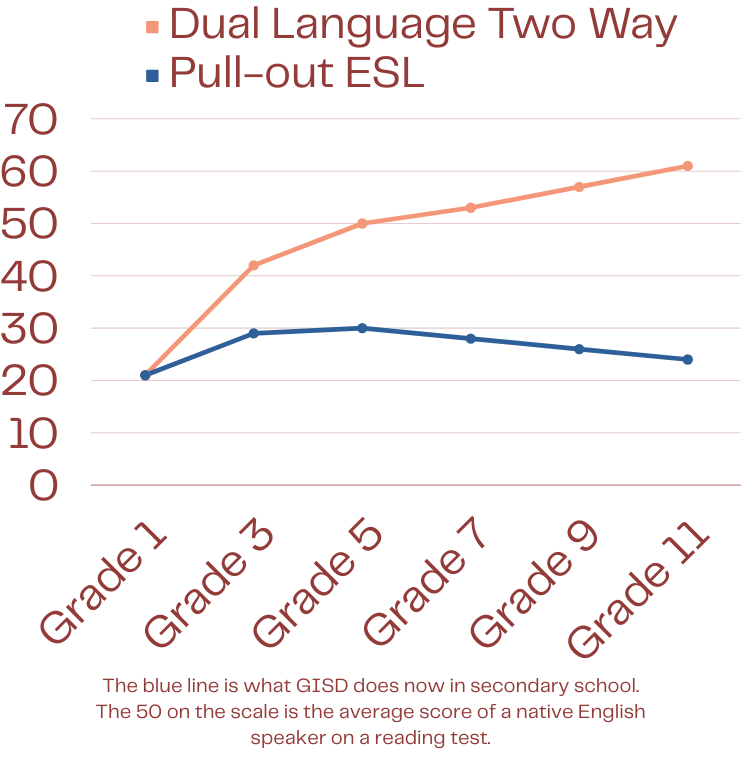
Expanding dual language education into secondary school enhances academics
The research below inspired the creation of this website. Simply put, academic gains increase *exponentially* when a dual language program continues into middle and high school. Native Spanish speaking students on the blue line in the graph (dual language) reach the dotted horizontal blue line (representing an average native English speaking student) faster than any other model-- sometime in middle school. Then, they soar academically up to 12th grade.
Let's finish the job that elementary dual language education started.
Academics
- Thomas and Collier (2012) demonstrated that English learners completely close the achievement gap in English reading, averaging at the 62nd normal curve (equivalent 71st percentile) on standardized English reading tests by the end of sixth grade. The graph above is based on the research from this paper.
- “It became clear within 2 years that the DL students were yielding statistically identifiable benefits on English-only standardized tests. Students who had had almost no command of English as sixth graders in the International Spanish Academy outperformed non-ISA students on the Florida Comprehensive Achievement Test by eighth grade after 3 years in the ISA. Remember, this is on a high-stakes test entirely in English. Students in our school continue to achieve at high levels on the current Florida Standards Assessments.” ~ Transforming Secondary Education by Collier & Thomas, p. 168
- Differences in performance in the two languages go away in the upper grades can be used as evidence that expanding a dual language program at least into middle school, is beneficial for the language and academic development of all students.~Howard and Zhao (2023)
- Most successful outcomes in English achievement… occurred among English learners who received home language instructional support over a longer period of time [more than six years]. Further, sustained and consistent dual language instruction benefits both English learners and native English speakers, and leads to achievement measured in English that is similar to or higher than that of matched groups who were in English mainstream programs. ~Howard et al. (2018:14) Guiding Principles for Dual Language Education
- English learners become proficient in English at higher rates by middle or high school.
- English Language Learners get reclassified to English-proficient at higher rates. Plus, they have higher English language arts academic achievement scores, and higher English reading, writing, speaking, and listening test results in the long run (Umansky & Reardon, 2014).
- Opportunity for the State of Texas Seal of Biliteracy which goes on the “Honors” section of the Common Application for universities and increases admission rates and scholarships
- It’s getting harder in Texas to be reclassified out of the Emergent Bilingual category but expanded dual language education is the answer.
- In another recent study involving more than 1,100 students attending two-way and one-way dual language programs in Portland (Oregon) Public Schools, Steele et al. (2017) found significant academic gains for students in dual language. The reading performance of eighth grade students in dual language was 7 to 9 months higher than a control group, and the English learner reclassification rate was also higher among students in dual language. There was no observable difference in math or science performance, but even that finding is significant since students had received some or all of their instruction in math and science in the partner language, and yet student achievement on English-language tests of those areas was not negatively impacted. ~Steele et al., 2017.
